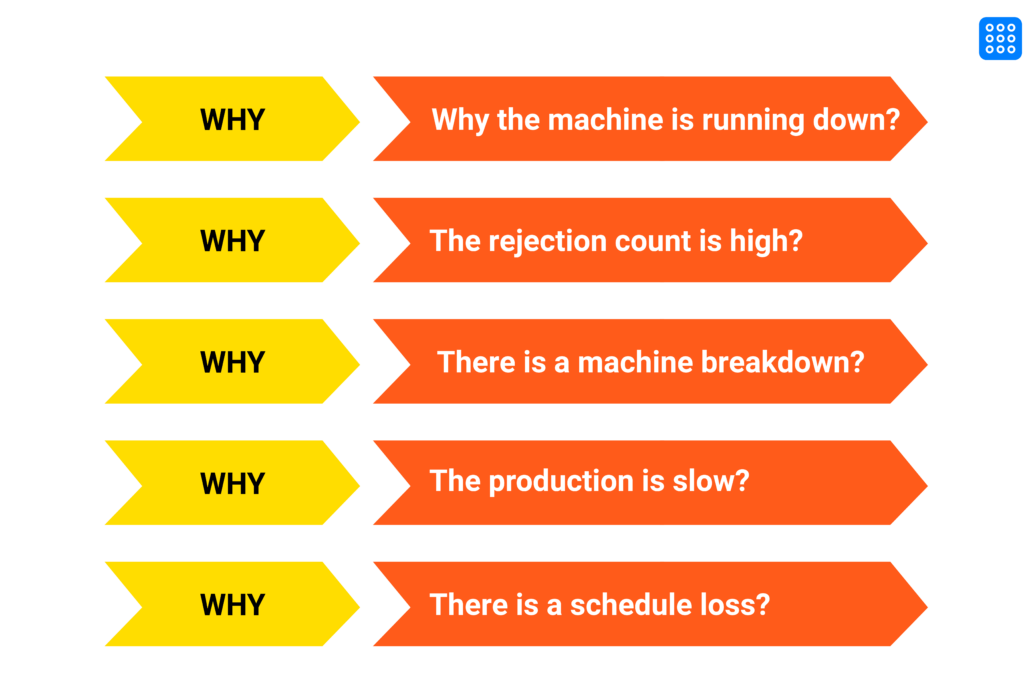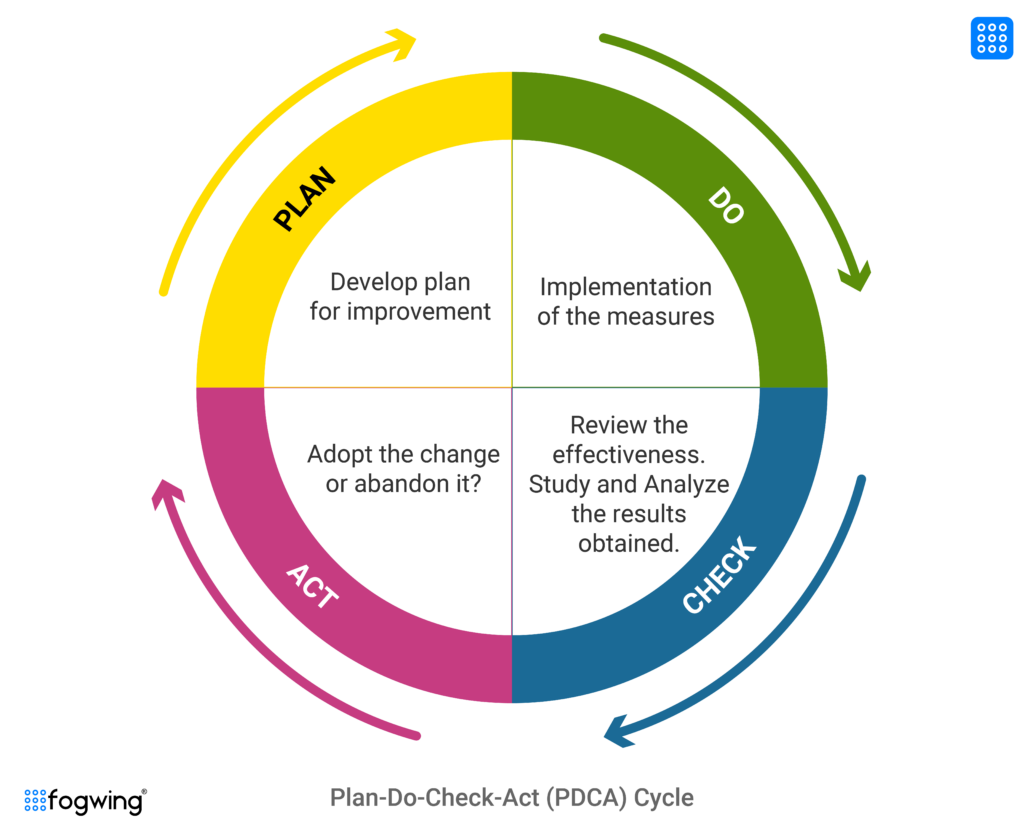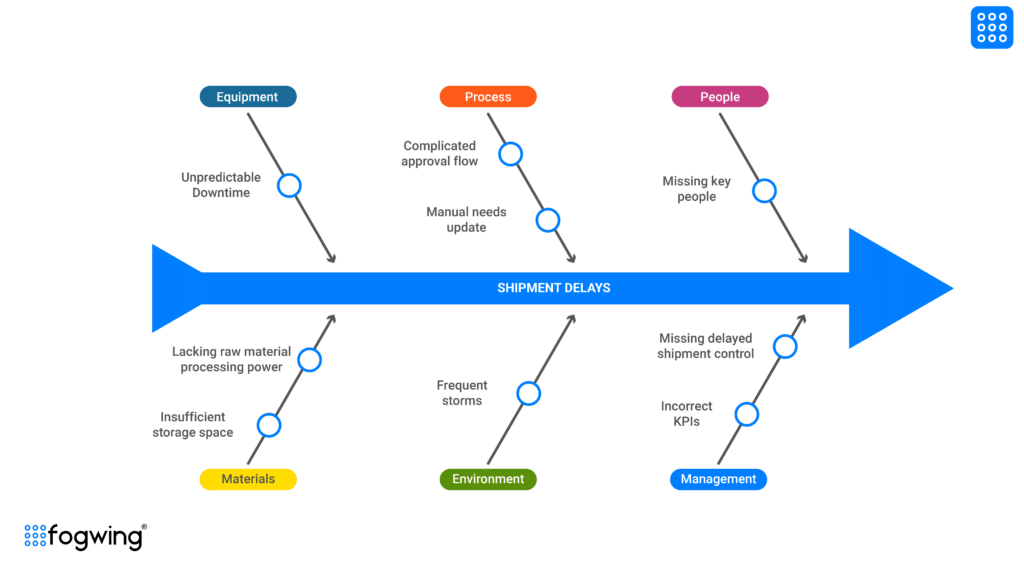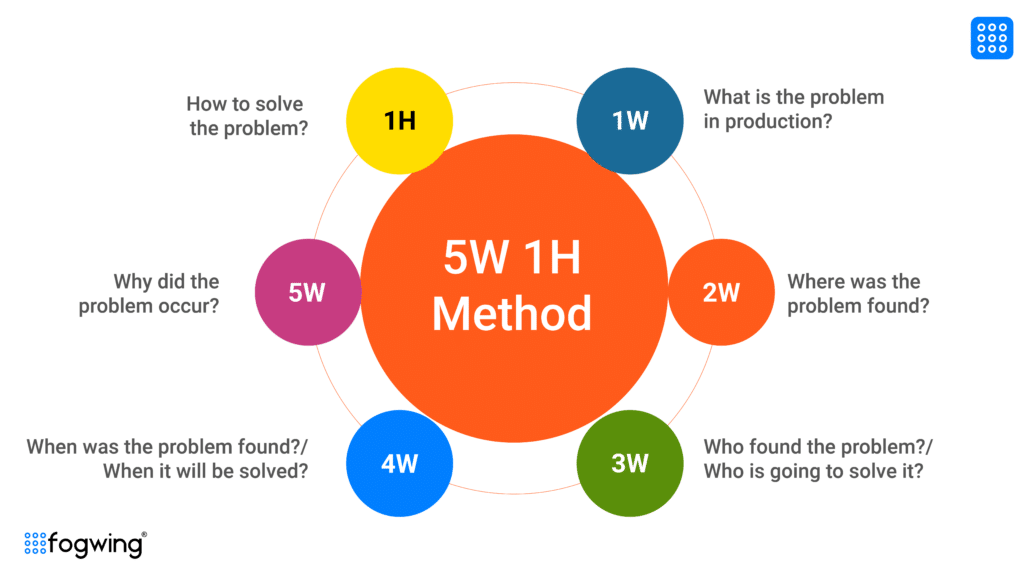Are you tired of being blindsided by production issues? Want to take control and become a Master of Production monitoring? Look no further; we offer you this comprehensive guide on “Mastering Production Monitoring with 5 Why Analysis.” In today’s fast-paced manufacturing world, swiftly identifying and resolving production issues is essential for maintaining efficiency and delivering high-quality products.
That’s where the 5 Whys analysis comes into play.
What is 5 Why Root Cause Analysis?
The 5 Why Root Cause Analysis is a fundamental problem-solving technique that delves deep into the core reasons behind an issue. As the name suggests, it involves asking “why” repeatedly, typically five times or more, to get to the underlying cause of a problem.
The method is often associated with the Toyota Production System as part of their pursuit of continuous improvement.
In any organization, it is essential to monitor performance to identify areas in need of improvement constantly. 5 Why analysis is a crucial tool that serves this purpose.
The 5 Why Root Cause Analysis is widely used across various industries, including manufacturing, healthcare, and service sectors. It is a valuable tool for problem-solving, process optimization, and quality improvement, helping organizations make data-driven decisions and strive for excellence in their operations.
The following image represents a 5 Why analysis example in the manufacturing industry.

What is PDCA Cycle?
The PDCA (Plan-Do-Check-Act) cycle is a systematic approach for continuous industry improvement. It involves four stages: Plan, where objectives and methods are determined; Do, where the plan is implemented; Check, where the outcomes are measured and compared against the goals; and Act, where necessary adjustments are made to improve the process.

This cycle allows manufacturers to continuously improve their processes, enhance product quality, reduce costs, and increase customer satisfaction. This data-driven approach provides a strong foundation for organizations’ continuous improvement of processes, products, services, and quality.
Different Tools in the PDCA Cycle
A few essential tools or techniques are frequently used in each phase of the PDCA cycle are:
The 5 Why Analysis
This technique is the most essential one, which can be used to dig deeper into each PDCA cycle stage to identify the root cause of any problem. This technique helps businesses detect and eliminate overall performance issues, resulting in continuous improvement.
The Fishbone Diagram

It is also known as the cause-effect diagram, can be used to analyze the root cause of a particular problem and helps to find a solution accordingly. Through this diagram, all the possible failure causes can be identified, categorized, and displayed. This tool is helpful in any analysis as it depicts the relationship between cause and effect in a rational manner.
5W1H Method

It is a technique for asking questions about a process or problem, is an essential tool. 5W1H represents: Who, What, When, Where, Why, and How. It is usually used when defining or analyzing a process or a problem for improvement opportunities and planning. The 5W1H method is an excellent tool for comprehensive data collection. By answering these six questions, you can understand the issue holistically and facilitate the 5 Why Analysis process.
Other problem-solving methodologies, such as Six Sigma and Lean, align well with The PDCA method or Cycle as it provides a systematic approach to making data-driven decisions and fostering a culture of continuous organizational improvement.
By embracing the PDCA Cycle, businesses can respond effectively to changes, enhance their competitive edge, and achieve sustained success in today’s dynamic and ever-evolving markets.
The PDCA Cycle, also known as the Deming Cycle or Plan-Do-Check-Act Cycle, is a systematic approach to continuous improvement. It has become a fundamental tool in various industries. It is widely used in quality management, process improvement, and organizational development.

What is Production Monitoring ?
Production monitoring involves the real-time observation and analysis of manufacturing processes to ensure smooth operations, adherence to quality standards, and the timely identification of issues. By monitoring Key Performance Indicators (KPIs) like production rate, downtime, cycle time, yield, uptime, and product quality, manufacturers can make data-driven decisions and respond proactively to potential problems.
These metrics can be tracked manually or through automated systems. Automated systems offer several advantages, including real-time data collection and Analysis, prevention of data entry errors, and automatic generation of reports.
Tracking historical data and current trends is essential regardless of the system. Businesses/operators can further analyze the data to identify problems and opportunities for improvement. Once issues are identified, root cause analysis or the 5 Why technique can be used to determine why they are occurring and what can be done to fix them.
With this information in hand, businesses can improve their production processes and ensure that they operate as efficiently as possible.
Benefits of 5 Why Analysis for Production Monitoring
The 5 Why Analysis is a powerful tool for production monitoring. It can also help you improve your processes by identifying areas where changes would be most effective. The following are the key benefits of the 5 Why technique.
1. Quickly finds and fixes problems: 5 Whys analysis can be used to diagnose production issues quickly and accurately. It allows production teams to make the necessary changes needed for efficient operations.
2. Helps identify possible improvements: By analyzing the various factors involved in each issue, 5 Why can help identify possibilities for improvement. It could include modifying existing processes, establishing new ones, or applying new technologies to streamline workflows.
3. Encourages deeper problem-solving: Rather than simply responding to problems as they arise, 5 Why Analysis encourages a more systematic approach to problem-solving – asking “why” each time a problem is identified offers a better understanding of the underlying causes of the issue and potential solutions beyond “quick fixes” that treat symptoms rather than causes.
4. Reduces undesirable downtime: Knowing why something has gone wrong helps quickly stabilize a system and reduce unwanted downtime while implementing a long-term solution. It means that fewer resources are wasted on recurring problems caused by inadequate root cause identification and Analysis in the first place.
5. Facilitates communication between stakeholders: By establishing standard procedures and using the 5 Why Analysis when troubleshooting, different stakeholders can more effectively collaborate on identifying and resolving problems. It contributes to the overall efficiency and success of production operations.
How to Implement 5 Why Analysis in Your Production System
Implementing the 5 Whys analysis in your production system requires a structured approach:
Form a Cross-Functional Team: Assemble a diverse team of individuals from different departments or areas of expertise. Involving multiple perspectives fosters a more comprehensive understanding of the problem and potential solutions.
Define the problem Clearly: Clearly articulate the issue or concern you aim to address through the 5 Why Analysis. A well-defined problem statement ensures the team focuses on the right area during the analysis.
Ask “Why” Repeatedly: Begin the 5 Whys analysis by asking “why” the problem occurred. With each answer, continue asking “why” until the team reaches a consensus on the root cause. The iterative nature of this process helps delve deeper into the issue and prevents stopping at superficial reasons.
Validate the Root Cause: Once the team identifies a potential root cause through the iterative “why” questioning, validate it with data and observations. Ensuring the accuracy of the identified cause is essential to implementing effective solutions.
Develop Countermeasures: Based on the validated root cause, brainstorm and develop practical countermeasures or corrective actions. The aim is to address the root cause directly to prevent the problem from recurring.
Implement and Monitor: Implement the countermeasures and closely monitor the results. Continuously assess the impact of the implemented solutions on production performance. Regular monitoring allows you to gauge the countermeasures’ effectiveness and make necessary adjustments.
Keep it Iterative: The 5 Why Analysis is an iterative process. If the implemented countermeasures do not yield the desired results or new issues arise, go back to the “why” questioning and adjust your solutions accordingly. Continuous improvement is critical to refining your production processes.
Tools and Resources Available for 5 Whys Analysis
Various tools and resources are available to support the implementation of the 5 Whys analysis and enhance its effectiveness in problem-solving and continuous improvement initiatives.
Some of these root cause analysis tools include:
Brainstorming Sessions: Conducting brainstorming sessions with cross-functional teams can generate diverse perspectives and insights. This collaborative approach aids in identifying potential root causes during the 5 Whys analysis.
5 Why Template: Pre-designed 5 Why Analysis templates offer a structured format for documenting the analysis steps and findings. These templates make it easier to track the progression of “why” questions and record the identified root cause and countermeasures.
Process Mapping Software: Utilizing process mapping software allows you to visualize the production process and potential points of failure or inefficiencies. This visual representation helps teams better understand the problem context during the Analysis.
Statistical Analysis Tools: Statistical analysis tools can aid in identifying patterns and trends in more complex issues or situations involving extensive data. These tools support data-driven decision-making during the 5 Whys Analysis process.
Root Cause Analysis Training: Offering training sessions on root cause analysis techniques, including the 5 Whys, ensures that team members understand the process and can contribute effectively to problem-solving efforts.
Production monitoring Software: Many production monitoring software solutions provide features for tracking and managing continuous improvement initiatives. These tools often integrate the 5 Why Analysis method, making implementing and monitoring improvement projects easier.
Problem-Solving Coaches or Consultants: Sometimes, organizations may seek external assistance from problem-solving experts or consultants specializing in the Five Why Analysis and other problem-solving methodologies. These experts can guide teams in applying the technique effectively.
Books and Publications: There are innumerable books and publications on root cause analysis and the 5 Why method. These resources offer in-depth insights and real-life examples of how the technique has been applied in various industries.
Online Resources and Templates: Several websites and platforms offer free or paid resources, including templates, guides, and articles, to support the 5 Why Analysis process.
Challenges Associated with Utilizing 5 Why Analysis
The 5 Whys analysis, while a valuable problem-solving technique, presents some challenges in its application. One such challenge is the potential for teams to stop at superficial answers, failing to reach the actual root cause. Subjectivity and biases can influence the identification of root causes, requiring careful management to maintain objectivity.
Additionally, the Analysis’s effectiveness relies on the availability and accuracy of data, making data collection a critical aspect. For complex issues with multiple intertwined root causes, untangling them can be time-consuming and demanding.
Moreover, the 5 Why Analysis may not be ideal for rare events, and its successful implementation depends on effective team collaboration. Significant challenges are overcoming resistance to change within the organization and distinguishing between symptoms and root causes.
By addressing these challenges thoughtfully, organizations can make the most of the 5 Whys technique to drive meaningful solutions and continuous improvement in their production processes.

5 Why analysis for Production Monitoring with SFactrix?
Machines/assets are primary and the most valuable resources in manufacturing. Ensuring that machines function to their full potential is crucial in achieving the ultimate production goal.
Fogwing production monitoring solution provides features like machine data collection and Overall Equipment Effectiveness (OEE) monitoring, which has proven to improve availability, performance rate, and quality production while reducing unplanned downtime, failure, and wastage from the equipment.
Fogwing production monitoring solution focuses on the 5 Why root cause analysis method to define a production problem and validate its root cause to achieve continuous quality improvement on the production floor.
Fogwing is an IoT-integrated production monitoring solution for monitoring the OEE and other performance, maintenance, and quality metrics to improve overall production efficiency. SFactrix production monitoring solution enables capturing real-time production data from your machines and monitoring OEE metrics or KPIs through a statistical representation on a digital platform.
By leveraging this real-time production monitoring solution, you can enhance your factory’s operational efficiency, reduce costs, and increase overall productivity and ROI.
Conclusion
5 Why Analysis is a potent problem-solving tool that can significantly improve manufacturing processes when applied in production monitoring. By consistently seeking the root cause of issues, manufacturers can implement targeted solutions, reduce downtime, and achieve a culture of continuous improvement.
Remember to integrate the 5W1H method for data collection and complement the Analysis with the PDCA cycle for sustained success in your production monitoring efforts. Embrace the power of the 5 Whys and avail the potential for enhanced efficiency and product quality in your manufacturing operations.
FAQs
1.What is 5 Why Analysis in production monitoring?
The 5 Why Analysis is a root cause analysis method used in production monitoring to identify the underlying reason for an issue by asking “why” multiple times—typically five or more. This helps manufacturers resolve recurring problems and improve efficiency by targeting the true cause rather than surface-level symptoms.
2. Why is the 5 Why Analysis important in manufacturing?
5 Why Analysis is essential in manufacturing because it enables teams to quickly diagnose production issues, reduce downtime, and implement lasting solutions. It encourages deep problem-solving and supports continuous improvement efforts by identifying process inefficiencies and quality defects
3. What are the benefits of using 5 Why Analysis in production monitoring?
Key benefits include:
- Quick problem identification
- Long-term solutions over short-term fixes
- Reduced equipment downtime
- Process and quality improvements
- Improved team collaboration and communication
4.How do you implement 5 Why Analysis in a factory?
To implement 5 Why Analysis:
- Form a cross-functional team
- Clearly define the problem
- Ask “why” repeatedly until the root cause is found
- Validate the root cause with data
- Develop and implement corrective actions
- Monitor the results and iterate as needed




